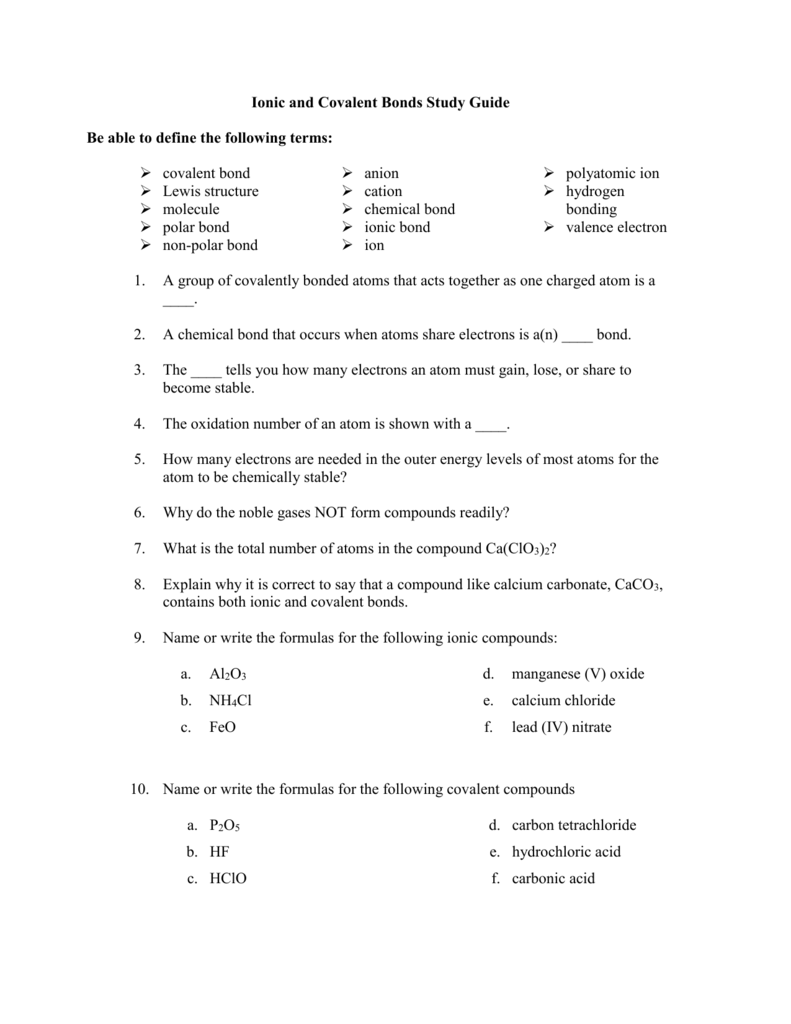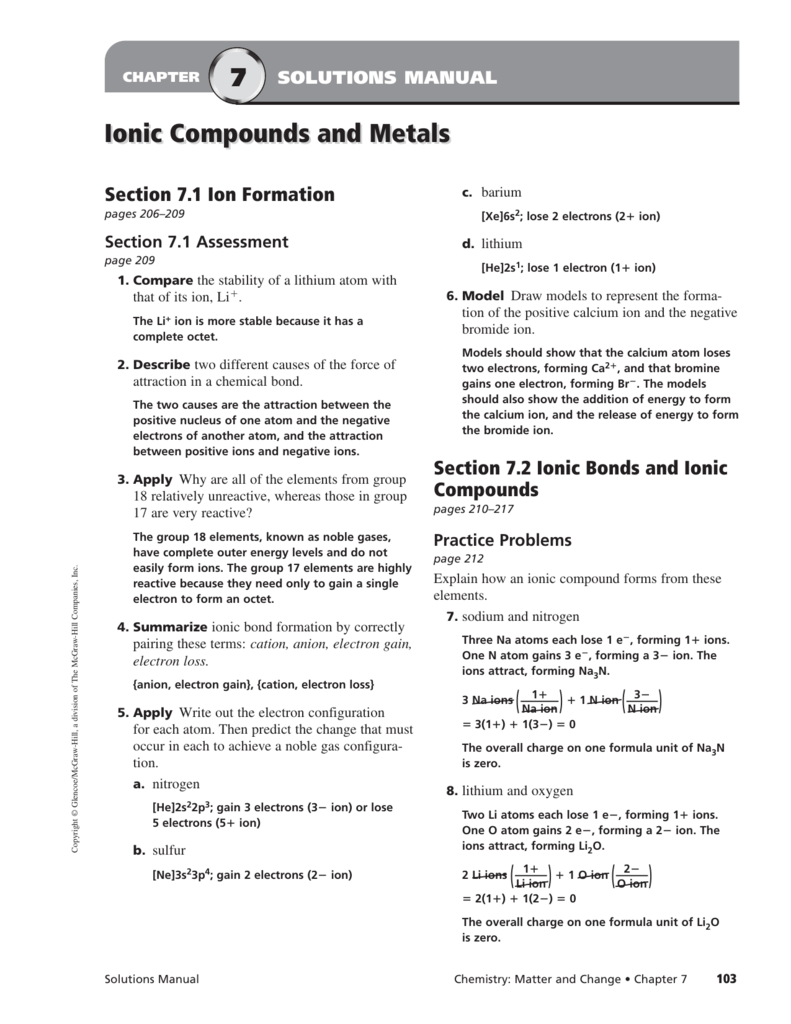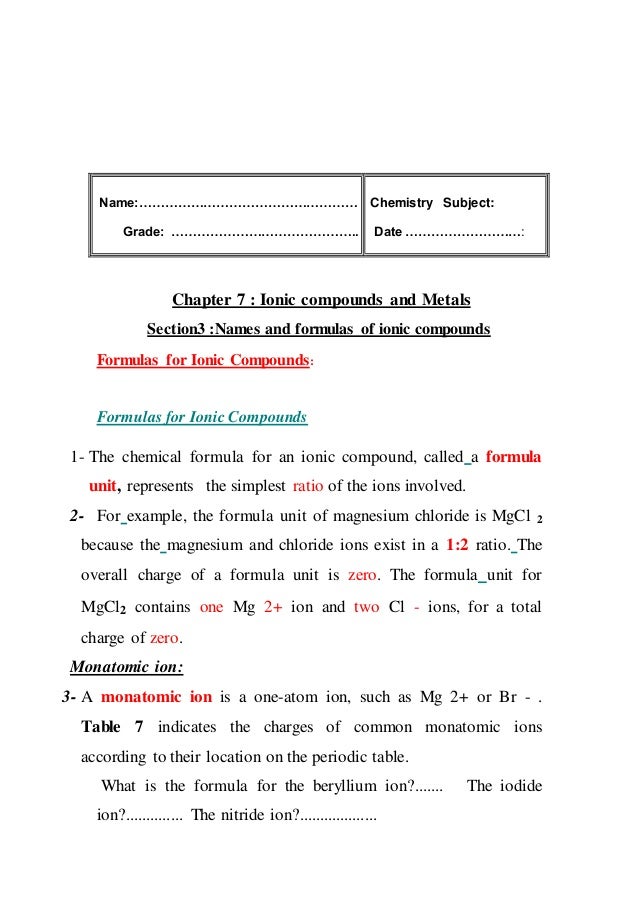Chapter 7 Study Guide Ionic Compounds And Metals
Chapter 7 Study Guide Ionic Compounds And Metals - The three types of strong bonds are: Compounds which contain an ionic bond. Exothermic or endothermic what happens in electron transfer involving a metallic atom and a non metallic atom during ion formation? Because a polyatomic ion exists as a unit, never change ________________ of the atoms within the ion. A compound that consists of positive and negative ions. Web start studying chapter 7: In your textbook, read about chemical bonds and formation of ions. Chemistry chapter 7 ionic compounds and metals. How is metallic bonding similar to ionic bonding? Learn vocabulary, terms, and more with flashcards, games, and other study.
Web start studying chapter 7: It is determined by the number of electrons shared from the metal. Web study with quizlet and memorize flashcards containing terms like chemical bond, cation, anion and more. The attraction of a metallic cation for delocalized electrons in a metallic solid. 7.3 names and formulas for ionic compounds main idea in written names and formulas for ionic compounds, the cation appears first, followed by the anion. Names and formulas for ionic compounds. In your textbook, read about chemical bonds and formation of ions. The energy needed to separate the ions in an ionic compound. Ionic compounds can conduct an electric current when melted or dissolved in water. 1.there is an attraction between particles of unlike.
Ionic , covalent , & metallic. The attraction of a metallic cation for delocalized electrons in a metallic solid. How is metallic bonding similar to ionic bonding? Use each of the terms below just. The charge of such an ion is equal to the atom's ______ ______, which is the number of _____ transferred to or from the atom to form the ion. In your textbook, read about chemical bonds and formation of ions. The three types of strong bonds are: In ionic compounds, the sum of the charges of all the ions. 1.there is an attraction between particles of unlike. Because a polyatomic ion exists as a unit, never change ________________ of the atoms within the ion.
Chapter 7 Study Guide Names And Formulas For Ionic Compounds Study Poster
In your textbook, read about chemical bonds and formation of ions. Chemistry chapter 7 ionic compounds and metals. The attraction of a metallic cation for delocalized electrons in a metallic solid. How is metallic bonding similar to ionic bonding? Ionic compounds can conduct an electric current when melted or dissolved in water.
Chemistry Chp 7 Ionic and Metallic Bonding Study Guide
Matter and change • chapter 7 study guide. A compound that consists of positive and negative ions. Contain a metallic cation and a non metallic anion (ex: It is determined by the number of electrons shared from the metal. Compounds which contain an ionic bond.
Chapter 7 Study Guide Names And Formulas For Ionic Compounds Study Poster
The charge of such an ion is equal to the atom's ______ ______, which is the number of _____ transferred to or from the atom to form the ion. A bond formed by the attraction between positively charged metal ions and the electrons cloud around them. Mettalic bonds and the properties of metals. Because a polyatomic ion exists as a.
Chapter 7 Ionic Compounds and Metals YouTube
• most ionic compounds are crystalline solids at room temperature, and they generally have high melting points. Web start studying chapter 7: Ionic bonds and ionic compounds. 1.there is an attraction between particles of unlike. A bond formed by the attraction between positively charged metal ions and the electrons cloud around them.
Chapter 7 Ionic Compounds and Metals
Web 7.2 ionic bonds and ionic compounds • although they are composed of ions, ionic compounds are electrically neutral. The energy needed to separate the ions in an ionic compound. The charge of such an ion is equal to the atom's ______ ______, which is the number of _____ transferred to or from the atom to form the ion. Quizlet.
Chapter 7 Review *Ionic and Metallic Bonding*
Names and formulas for ionic compounds. 7.3 names and formulas for ionic compounds main idea in written names and formulas for ionic compounds, the cation appears first, followed by the anion. Create flashcards for free and quiz yourself with an interactive flipper. Ionic compounds and metals study guide by lawanda_wilkerson includes 25 questions covering vocabulary, terms and more. In ionic.
Chapter 7 Ionic Compounds And Metals Study Guide Study Poster
Create flashcards for free and quiz yourself with an interactive flipper. How is metallic bonding similar to ionic bonding? Mettalic bonds and the properties of metals. Exothermic or endothermic what happens in electron transfer involving a metallic atom and a non metallic atom during ion formation? Quizlet flashcards, activities and games help you improve your grades.
Chapter 7 Ionic Compounds and Metals Pt III YouTube
The charge of such an ion is equal to the atom's ______ ______, which is the number of _____ transferred to or from the atom to form the ion. Chemistry chapter 7 ionic compounds and metals. Web design a concept map that shows the relationships among ionic bond strength, physical properties of ionic compounds, lattice energy, and stability. Ionic compounds.
Solutions Manual
In your textbook, read about chemical bonds and formation of ions. Ionic bonds and ionic compounds. A compound that consists of positive and negative ions. Web learn how to write ionic compound formulas for binary and polyatomic compounds and explore some examples of both. Web study with quizlet and memorize flashcards containing terms like chemical bond, cation, anion and more.
Chapter 7 Study Guide Names And Formulas For Ionic Compounds Study Poster
Quizlet flashcards, activities and games help you improve your grades. Web 7.2 ionic bonds and ionic compounds • although they are composed of ions, ionic compounds are electrically neutral. Matter and change • chapter 7 study guide. Create flashcards for free and quiz yourself with an interactive flipper. It is determined by the number of electrons shared from the metal.
Names And Formulas For Ionic Compounds.
Web what can the formation of a stable ionic compound from ions be? The energy needed to separate the ions in an ionic compound. Learn vocabulary, terms, and more with flashcards, games, and other study. A bond formed by the attraction between positively charged metal ions and the electrons cloud around them.
The Three Types Of Strong Bonds Are:
Learn vocabulary, terms, and more with flashcards, games, and other study tools. Chemistry chapter 7 ionic compounds and metals. Create flashcards for free and quiz yourself with an interactive flipper. Web learn how to write ionic compound formulas for binary and polyatomic compounds and explore some examples of both.
Because A Polyatomic Ion Exists As A Unit, Never Change ________________ Of The Atoms Within The Ion.
Web many ionic compounds contain _____ ions, which are ions made up of more than one atom. Web design a concept map that shows the relationships among ionic bond strength, physical properties of ionic compounds, lattice energy, and stability. Matter and change • chapter 7 study guide. Ionic bonds and ionic compounds.
It Is Determined By The Number Of Electrons Shared From The Metal.
Web study with quizlet and memorize flashcards containing terms like chemical bond, cation, anion and more. In your textbook, read about chemical bonds and formation of ions. Ionic compounds can conduct an electric current when melted or dissolved in water. The charge of such an ion is equal to the atom's ______ ______, which is the number of _____ transferred to or from the atom to form the ion.









